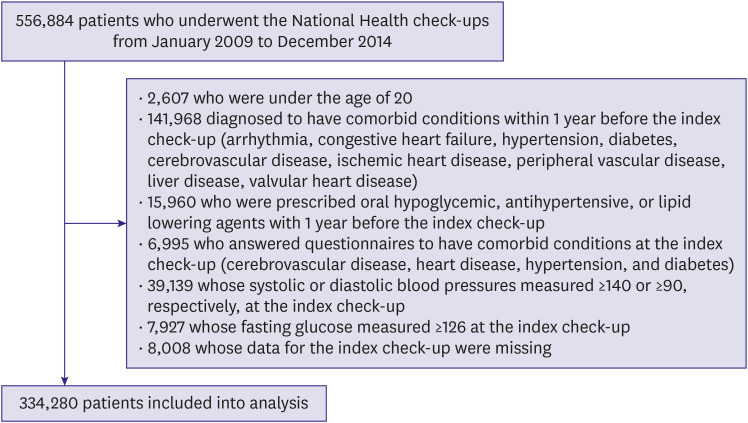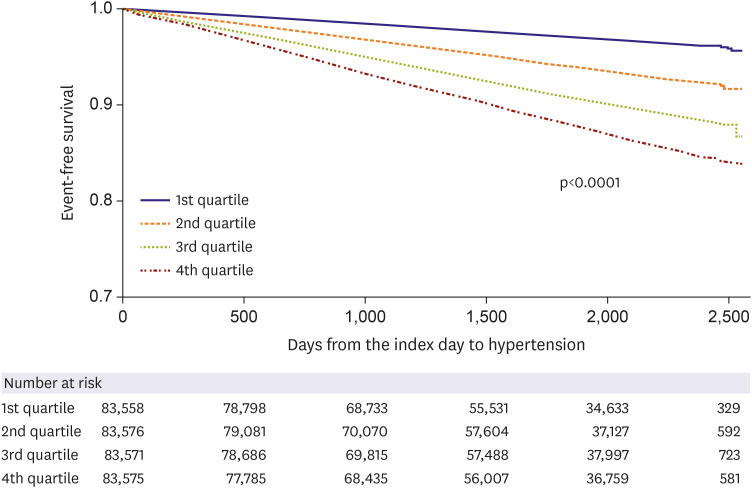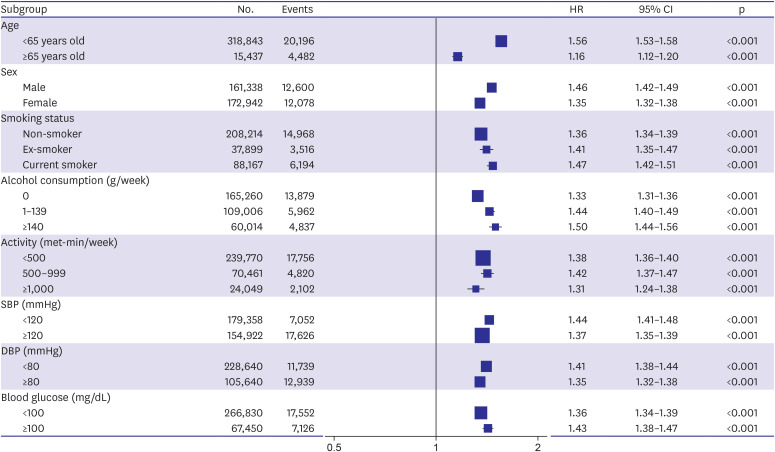Korean Circ J.
2020 Aug;50(8):695-705. 10.4070/kcj.2019.0379.
A Close Relationship between Non-Alcoholic Fatty Liver Disease Markerand New-Onset Hypertension inHealthy Korean Adults
- Affiliations
-
- 1Department of Cardiology in Internal Medicine, Chungnam National University Hospital, Chungnam National University School of Medicine, Daejeon, Korea
- 2Department of Statistics, Kyungpook National University, Daegu, Korea
- 3Department of Cardiology, Ulsan University Hospital, University of Ulsan College of Medicine, Ulsan, Korea
- KMID: 2505123
- DOI: http://doi.org/10.4070/kcj.2019.0379
Abstract
- Background and Objectives
Nonalcoholic fatty liver disease (NAFLD) is an excessiveaccumulation of fat into the liver as a result of increased inflammation and insulin resistance.Although there can be common pathogenic mechanisms for NAFLD and hypertensionassociated with the development of cardiovascular diseases, little data are showing theassociation between NAFLD and hypertension in a large-scale cohort study. Thus, weevaluated the ability of the fatty liver index (FLI), a surrogate marker of NAFLD, to predict thedevelopment of hypertension in healthy individuals.
Methods
We included 334,280 healthy individuals without known comorbidities whounderwent the National Health check-ups in South Korea from 2009 to 2014. Theassociation between the FLI and hypertension was analyzed using multivariate Coxproportional-hazards models.
Results
During a median of 5.2 years' follow-up, 24,678 subjects (7.4%) had new-onsethypertension. We categorized total subjects into quartile groups according to FLI (range: Q1,0–4.9; Q2, 5.0–12.5; Q3, 12.6–31.0; and Q4, >31.0). The incidence of hypertension was higherin subjects with the highest FLI than in those with the lowest FLI (Q4, 9,968 [11.9%] vs. Q1,2,277 [2.7%]; p<0.001). There was a significant correlation between the highest FLI and anincreased risk of new-onset hypertension (adjusted hazard ratio between Q4 and Q1, 2.330;95% confidence interval, 2.218–2.448; p<0.001). FLI was significantly associated with anincreased risk of new-onset hypertension regardless of baseline characteristics.
Conclusions
Higher FLI was independently associated with increased risk of hypertension ina healthy Korean population.
Figure
Cited by 1 articles
-
Non-alcoholic Fatty Liver Disease, Cardio-metabolic Syndrome and Hypertension: One Concept Fits Multi-systemic Presentations
Mi-Jeong Kim
Korean Circ J. 2020;50(8):706-708. doi: 10.4070/kcj.2020.0217.
Reference
-
1. McPherson S, Hardy T, Henderson E, Burt AD, Day CP, Anstee QM. Evidence of NAFLD progression from steatosis to fibrosing-steatohepatitis using paired biopsies: implications for prognosis and clinical management. J Hepatol. 2015; 62:1148–1155. PMID: 25477264.
Article2. Targher G, Day CP, Bonora E. Risk of cardiovascular disease in patients with nonalcoholic fatty liver disease. N Engl J Med. 2010; 363:1341–1350. PMID: 20879883.
Article3. Adams LA, Anstee QM, Tilg H, Targher G. Non-alcoholic fatty liver disease and its relationship with cardiovascular disease and other extrahepatic diseases. Gut. 2017; 66:1138–1153. PMID: 28314735.
Article4. Angulo P. Nonalcoholic fatty liver disease. N Engl J Med. 2002; 346:1221–1231. PMID: 11961152.
Article5. Angulo P, Kleiner DE, Dam-Larsen S, et al. Liver fibrosis, but no other histologic features, is associated with long-term outcomes of patients with nonalcoholic fatty liver disease. Gastroenterology. 2015; 149:389–397.e10. PMID: 25935633.
Article6. Kim HC, Ihm SH, Kim GH, et al. 2018 Korean Society of Hypertension guidelines for the management of hypertension: part I-epidemiology of hypertension. Clin Hypertens. 2019; 25:16. PMID: 31388451.
Article7. Whelton PK, Carey RM, Aronow WS, et al. 2017 ACC/AHA/AAPA/ABC/ACPM/AGS/APhA/ASH/ASPC/NMA/PCNA guideline for the prevention, detection, evaluation, and management of high blood pressure in adults: a report of the American College of Cardiology/American Heart Association task force on clinical practice guidelines. Circulation. 2018; 138:e484–e594. PMID: 30354654.8. Benjamin EJ, Muntner P, Alonso A, et al. Heart disease and stroke statistics-2019 update: a report from the American Heart Association. Circulation. 2019; 139:e56–528. PMID: 30700139.9. Ryoo JH, Suh YJ, Shin HC, Cho YK, Choi JM, Park SK. Clinical association between non-alcoholic fatty liver disease and the development of hypertension. J Gastroenterol Hepatol. 2014; 29:1926–1931. PMID: 24910023.
Article10. Lee J, Lee JS, Park SH, Shin SA, Kim K. Cohort profile: the National Health Insurance Service-National Sample Cohort (NHIS-NSC), South Korea. Int J Epidemiol. 2017; 46:e15. PMID: 26822938.
Article11. Bedogni G, Bellentani S, Miglioli L, et al. The fatty liver index: a simple and accurate predictor of hepatic steatosis in the general population. BMC Gastroenterol. 2006; 6:33. PMID: 17081293.
Article12. Grundy SM, Cleeman JI, Daniels SR, et al. Diagnosis and management of the metabolic syndrome: an American Heart Association/National Heart, Lung, and Blood Institute scientific statement. Circulation. 2005; 112:2735–2752. PMID: 16157765.13. Yang BL, Wu WC, Fang KC, et al. External validation of fatty liver index for identifying ultrasonographic fatty liver in a large-scale cross-sectional study in Taiwan. PLoS One. 2015; 10:e0120443. PMID: 25781622.
Article14. Donati G, Stagni B, Piscaglia F, et al. Increased prevalence of fatty liver in arterial hypertensive patients with normal liver enzymes: role of insulin resistance. Gut. 2004; 53:1020–1023. PMID: 15194655.
Article15. Aneni EC, Oni ET, Martin SS, et al. Blood pressure is associated with the presence and severity of nonalcoholic fatty liver disease across the spectrum of cardiometabolic risk. J Hypertens. 2015; 33:1207–1214. PMID: 25693058.
Article16. Wang Y, Zeng Y, Lin C, Chen Z. Hypertension and non-alcoholic fatty liver disease proven by transient elastography. Hepatol Res. 2016; 46:1304–1310. PMID: 26932594.
Article17. Sung KC, Wild SH, Byrne CD. Development of new fatty liver, or resolution of existing fatty liver, over five years of follow-up, and risk of incident hypertension. J Hepatol. 2014; 60:1040–1045. PMID: 24445219.
Article18. Huh JH, Ahn SV, Koh SB, et al. A prospective study of fatty liver index and incident hypertension: the KoGES-ARIRANG study. PLoS One. 2015; 10:e0143560. PMID: 26618774.
Article19. Saad MF, Rewers M, Selby J, et al. Insulin resistance and hypertension: the insulin resistance atherosclerosis study. Hypertension. 2004; 43:1324–1331. PMID: 15123571.20. Reaven GM, Hoffman BB. A role for insulin in the aetiology and course of hypertension? Lancet. 1987; 2:435–437. PMID: 2887735.
Article21. Sigala B, McKee C, Soeda J, et al. Sympathetic nervous system catecholamines and neuropeptide Y neurotransmitters are upregulated in human NAFLD and modulate the fibrogenic function of hepatic stellate cells. PLoS One. 2013; 8:e72928. PMID: 24019886.
Article22. Bataller R, Sancho-Bru P, Ginès P, et al. Activated human hepatic stellate cells express the renin-angiotensin system and synthesize angiotensin II. Gastroenterology. 2003; 125:117–125. PMID: 12851877.
Article23. Warner FJ, Lubel JS, McCaughan GW, Angus PW. Liver fibrosis: a balance of ACEs? Clin Sci (Lond). 2007; 113:109–118. PMID: 17600527.
Article24. Hirose A, Ono M, Saibara T, et al. Angiotensin II type 1 receptor blocker inhibits fibrosis in rat nonalcoholic steatohepatitis. Hepatology. 2007; 45:1375–1381. PMID: 17518368.
Article25. Brandes RP. Endothelial dysfunction and hypertension. Hypertension. 2014; 64:924–928. PMID: 25156167.
Article26. Yoo HJ, Choi KM. Hepatokines as a link between obesity and cardiovascular diseases. Diabetes Metab J. 2015; 39:10–15. PMID: 25729707.
Article27. VanWagner LB, Wilcox JE, Colangelo LA, et al. Association of nonalcoholic fatty liver disease with subclinical myocardial remodeling and dysfunction: a population-based study. Hepatology. 2015; 62:773–783. PMID: 25914296.
Article
- Full Text Links
- Actions
-
Cited
- CITED
-
- Close
- Share
- Similar articles
-
- Should you advocate for hepatocellular carcinomasurveillance in patients with alcohol-related liverdisease or non-alcoholic fatty liver disease?
- Gut Microbiota and Clinical Disease: Obesity and Nonalcoholic Fatty Liver Disease
- Cardiovascular Risk in Patients with Non-alcoholic Fatty Liver Disease
- How to optimize the outcome of liver transplantation for non-alcoholic fatty liver disease
- A Case of Hepatocellular Carcinoma in Non-alcoholic Fatty Liver Disease




